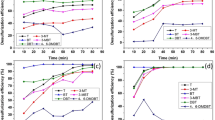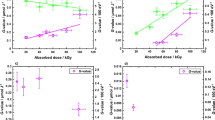Abstract
Hydrodesulfurization (HDS) is the process by which sulfur-containing impurities are removed from petroleum streams, typically using a heterogeneous, sulfided transition metal catalyst under high H2 pressures and temperatures. Although generally effective, a major obstacle that remains is the desulfurization of highly refractory sulfur-containing heterocycles, such as 4,6-dimethyldibenzothiophene (4,6-Me2DBT), which are naturally occurring in fossil fuels. Homogeneous HDS strategies using well-defined molecular catalysts have been designed to target these recalcitrant S-heterocycles; however, the formation of stable transition metal sulfide complexes following C–S bond activation has largely prevented catalytic turnover. Here we show that a robust potassium (K) alkoxide (O)/hydrosilane (Si)-based (‘KOSi’) system efficiently desulfurizes refractory sulfur heterocycles. Subjecting sulfur-rich diesel (that is, [S] ∼ 10,000 ppm) to KOSi conditions results in a fuel with [S] ∼ 2 ppm, surpassing ambitious future governmental regulatory goals set for fuel sulfur content in all countries.
This is a preview of subscription content, access via your institution
Access options
Access Nature and 54 other Nature Portfolio journals
Get Nature+, our best-value online-access subscription
$29.99 / 30 days
cancel any time
Subscribe to this journal
Receive 12 digital issues and online access to articles
$119.00 per year
only $9.92 per issue
Buy this article
- Purchase on Springer Link
- Instant access to full article PDF
Prices may be subject to local taxes which are calculated during checkout




Similar content being viewed by others
References
Stirling, D. The Sulfur Problem: Cleaning up Industrial Feedstocks (ed. Clark, J. H. ) (RSC Clean Technology Monographs, RSC, 2000).
Ho, T. C. Deep HDS of diesel fuel: chemistry and catalysis. Catal. Today 98, 3–18 (2004).
Angelici, R. J. Hydrodesulfurization & Hydrodenitrogenation (Encyclopedia of Inorganic Chemistry, Wiley, 2006); http://doi.org/10.1002/0470862106.ia090
Prins, R. et al. Mechanisms of hydrodesulfurization and hydrodenitrogenation. Catal. Today 111, 84–93 (2006).
Girgis, M. J. & Gates, B. C. Reactivities, reaction networks, and kinetics in high-pressure catalytic hydroprocessing. Ind. Eng. Chem. Res. 30, 2021–2058 (1991).
Vicic, D. A. & Jones, W. D. Deep hydrodesulfurization in homogeneous solution: access to a transition-metal insertion complex of 4,6-dimethyldibenzothiophene. Organometallics 17, 3411–3413 (1998).
Vicic, D. A. & Jones, W. D. Modeling the hydrodesulfurization reaction at nickel. Unusual reactivity of dibenzothiophenes relative to thiophene and benzothiophene. J. Am. Chem. Soc. 121, 7606–7617 (1999).
Sattler, A. & Parkin, G. Carbon–sulfur bond cleavage and hydrodesulfurization of thiophenes by tungsten. J. Am. Chem. Soc. 133, 3748–3751 (2011).
Sattler, A., Janak, K. E. & Parkin, G. Modeling aspects of hydrodesulfurization by molybdenum hydride compounds: desulfurization of thiophene and benzothiophene and C–S bond cleavage of dibenzothiophene. Inorg. Chim. Acta 369, 197–202 (2011).
Lin, S., Herbert, D. E., Velian, A., Day, M. W. & Agapie, T. Dipalladium(I) terphenyl diphosphine complexes as models for two-site adsorption and activation of organic molecules. J. Am. Chem. Soc. 135, 15830–15840 (2013).
Hirotsu, M., Tsuboi, C., Nishioka, T. & Kinoshita, I. Carbon–sulfur bond cleavage reactions of dibenzothiophene derivatives mediated by iron and ruthenium carbonyls. Dalton Trans. 40, 785–787 (2011).
Oster, S. S., Grochowski, M. R., Lachicotte, R. J., Brennessel, W. W. & Jones, W. D. Carbon-sulfur bond activation of dibenzothiophenes and phenoxythiin by [Rh(dippe)(𝜇-H)]2 and [Rh2(dippe)2(𝜇-Cl)(𝜇-H)]. Organometallics 29, 4923–4931 (2010).
Furimsky, E. & Massoth, F. E. Regeneration of hydroprocessing catalysts. Catal. Today 17, 537–660 (1993).
Torres-Nieto, J., Arévalo, A., García-Gutiérrez, P., Acosta-Ramíez, A. & García, J. J. Catalytic desulfurization of dibenzothiophene and 4,6-dimethyldibenzothiophene with nickel compounds. Organometallics 23, 4534–4536 (2004).
Bunquin, J. C. & Stryker, J. M. Transition metal catalysts for hydrodesulfurization. US patent US20140174989 A1 (2014).
Sunyer, J. et al. The association of daily sulfur dioxide air pollution levels with hospital admissions for cardiovascular diseases in Europe (The Aphea-II study). Eur. Heart J. 24, 752–760 (2003).
Fedorov, A., Toutov, A. A., Swisher, N. A. & Grubbs, R. H. Lewis-base silane activation: from reductive cleavage of aryl ethers to selective ortho-silylation. Chem. Sci. 4, 1640–1645 (2013).
Buccella, D. & Janak, K. E. Reactivity of Mo(PMe3)6 towards benzothiophene and selenophenes: new pathways relevant to hydrodesulfurization. J. Am. Chem. Soc. 130, 16187–16189 (2008).
Bianchini, C., Meli, A. & Vizza, F. Role of single-site catalysts in the hydrogenation of thiophenes: from models systems to effective HDS catalysts. J. Organomet. Chem. 689, 4277–4290 (2004).
Chehata, A., Oviedo, A., Arévalo, A., Bernès, S. & García, J. J. Reactivity of [Ru3(CO)12] with dibenzothiophene, methylbenzothiophene, and methyldibenzothiophene. Organometallics 22, 1585–1587 (2003).
Garcia, J. J. & Maitlis, P. Hydrodesulfurization of dibenzothiophene into biphenyl by tris(triethylphosphine)platinum(0). J. Am. Chem. Soc. 115, 12200–12201 (1993).
Ma, X., Sakanishi, K. & Mochida, I. Hydrodesulfurization reactivities of various sulfur compounds in diesel fuel. Ind. Eng. Chem. Res. 33, 218–222 (1994).
Wang, L., He, W. & Yu, Z. Transition-metal mediated carbon–sulfur bond activation and transformations. Chem. Soc. Rev. 42, 599–621 (2013).
Lawrence, N. J., Drew, M. D. & Bushell, S. M. Polymethylhydrosiloxane: a versatile reducing agent for organic synthesis. J. Chem. Soc. 1, 3381–3391 (1999).
Toutov, A. A. et al. Silylation of C–H bonds in aromatic heterocycles by an Earth-abundant metal catalyst. Nature 518, 80–85 (2015).
Toutov, A. A., Liu, W.-B., Betz, K. N., Stoltz, B. M. & Grubbs, R. H. Catalytic C–H bond silylation of aromatic heterocycles. Nat. Protoc. 10, 1897–1903 (2015).
Postigo, A., Kopsov, S., Zlotsky, S. S., Ferreri, C. & Chatgilialoglu, C. Hydrosilylation of C–C multiple bonds using (Me3Si)3SiH in water. Comparative study of the radical initiation step. Organometallics 28, 3282–3287 (2009).
Barham, J. P. et al. KOtBu: a privileged reagent for electron transfer reactions? J. Am. Chem. Soc. 138, 7402–7410 (2016).
Studer, A. & Curran, D. P. Organocatalysis and C–H activation meet radical- and electron-transfer reactions. Angew. Chem. Int. Ed. 50, 5018–5022 (2011).
Studer, A. & Curran, D. P. The electron is a catalyst. Nat. Chem. 6, 765–773 (2014).
Fukumoto, K., Sakai, A., Oya, T. & Nakazawa, H. Desulfurization of N,N-dimethylthioformamide by hydrosilane with the help of an iron complex. Isolation and characterization of an iron–carbene complex as an intermediate of C =S double bond cleavage. Chem. Commun. 48, 3809–3811 (2012).
Kukula, P., Dutly, A., Rüegger, H. & Prins, R. Molecular rearrangement in the Birch reduction of dibenzothiophenes. Tetrahedron Lett. 48, 5657–5659 (2007).
Pangborn, A. M., Giardello, M. A., Grubbs, R. H., Rosen, R. K. & Timmers, F. J. Safe and convenient procedure for solvent purification. Organometallics 15, 1518–1520 (1996).
Frisch, M. J. et al. Gaussian 09 Revision D.01 (Gaussian Inc., 2013).
Becke, A. D. Density functional thermochemistry. III. The role of exact exchange. J. Chem. Phys. 98, 5648–5652 (1993).
Ditchfield, R., Hehre, W. J. & Pople, J. A. Self-consistent molecular-orbital methods. IX. An extended Gaussian-type basis for molecular-orbital studies of organic molecules. J. Chem. Phys. 54, 724–728 (1971).
Zhao, Y. & Truhlar, D. G. Density functionals with broad applicability in chemistry. Acc. Chem. Res. 41, 157–167 (2008).
Legault, C. Y. CYLview 1.0b (Université de Sherbrooke, 2009); http://www.cylview.org
Acknowledgements
Support of this work by BP under the XC2 program is gratefully acknowledged. A.A.T. is additionally grateful to the Resnick Sustainability Institute at Caltech, Dow Chemical, and Bristol–Myers Squibb for predoctoral fellowships, and to NSERC for a PGS D fellowship. K.N.H. is grateful to the US National Science Foundation (CHE-1205646 and CHE-1361104) for financial support and to the Extreme Science and Engineering Discovery Environment (XSEDE), which is supported by the US National Science Foundation (OCI-1053575). Y.L. thanks the ‘National Thousand Young Talents Program’ and ‘Jiangsu Specially-Appointed Professor Plan’ in China for financial support. E.P.A.C. thanks K. Lammertsma (Division of Organic Chemistry, Vrije Universiteit Amsterdam, The Netherlands) for access to, and SURFsara (www.surfsara.nl) for their support in using the Lisa Computer Cluster. G. Huff, G. Sunley, D. Braden, P. Metelski, M. Pinderski, E. Doskocil, A. Lucy, C. Buda, A. Dinse, R. Taylor, J. Bercaw, J. Labinger, M. Howard, M. Desmond, J. Elks, D. Leitch and F. Bell are gratefully thanked for technical contributions and/or invaluable discussion.
Author information
Authors and Affiliations
Contributions
A.A.T., A.F. and R.H.G. had the idea and designed experiments with M.S., J.W.S., R.C. and K.N.B. A.A.T., M.S., A.F. and K.N.B. performed experiments and analysed data. Y.-F.Y., Y.L., E.P.A.C. and K.N.H. designed, performed, analysed, and interpreted density functional theory calculations. A.A.T., A.F., M.S., K.N.B. and E.P.A.C. wrote the manuscript with contributions from all authors. All authors contributed to discussions.
Corresponding authors
Ethics declarations
Competing interests
A company commercializing the technology reported in this paper is being founded and one of the authors (A.A.T.) will be a co-founder. The other authors declare no competing interests.
Supplementary information
Supplementary Information
Supplementary Notes 1–7, Supplementary Figures 1–7, Supplementary Table 1. (PDF 1014 kb)
Supplementary Data 1
Cartesian coordinates of calculated structures. (XLSX 60 kb)
Rights and permissions
About this article
Cite this article
Toutov, A., Salata, M., Fedorov, A. et al. A potassium tert-butoxide and hydrosilane system for ultra-deep desulfurization of fuels. Nat Energy 2, 17008 (2017). https://doi.org/10.1038/nenergy.2017.8
Received:
Accepted:
Published:
DOI: https://doi.org/10.1038/nenergy.2017.8
This article is cited by
-
Enhancing oxidation resistance of Cu(I) by tailoring microenvironment in zeolites for efficient adsorptive desulfurization
Nature Communications (2020)
-
Transportation fuels: Desulfurizing diesel
Nature Energy (2017)



